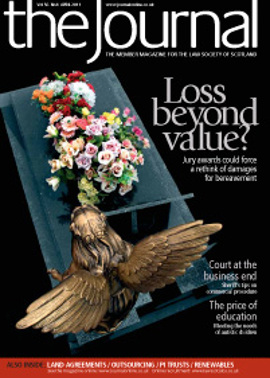It's an ill wind...

During the past decade, Scotland has witnessed an unprecedented growth in renewable energy projects. Stimulated by the UK Government’s introduction of the Renewable Obligation Certificate (ROC) scheme in 2002 and more recently the Feed-in Tariff (FIT) scheme established in 2010 (for projects under 5MW), energy companies have invested significant resources and technology into the evolution particularly of onshore wind power and hydro-electricity, of which the latter has seen a renaissance in Scotland.
Scottish farms and estates involved have in many instances seen a vast increase in viability, even though many of the early arrangements offered by developers were generally on less favourable financial terms than today’s comparables. Yet whilst the economic change of fortune to landowners has seemed an obvious and significant boon, on further analysis a number of renewables developments could have the potential to penalise landowners from a fiscal point of view.
This article explores some of those fiscal traps, and highlights alternative legal structures for renewable energy projects that are currently being used to mitigate capital tax exposure to landowners.
Gold rush
Until recently, most developers have secured their interests in a renewables project on land owned by another party via a long-term lease capable of registration. This has been driven in part by convention on analogous issues in the rural economy (such as quarrying and telephone masts), but also because of the security that a registered long lease can provide to lenders. In the more pioneering days of renewables agreements some five to 10 years ago, where developers were fewer and potential landowners more plentiful, market conditions favoured the developers, enabling them to obtain agreements along preferred lines. Many farmers and landowners, as beneficiaries of prospective cashflow windfalls which in some cases represented the difference between being able to retain instead of sell a property, were keen to take advantage of this “Klondike” opportunity.
However, whilst a significant injection of cashflow from leased renewables projects has been perceived as a saviour to many landowners, that very cashflow now potentially represents for them and others a significant fiscal threat.
Storing up problems?
Wind farm lease arrangements typically run for a period of around 25 to 30 years, sometimes with an extension for up to 50 years. Hydro-electricity agreements tend typically to last for anything between 40 and 100 years. The incidence of capital taxation arising within those periods is therefore almost inevitable.
From a revenue taxation perspective, investment income arising under a lease is potentially taxable at higher rates of income tax – 50% top rate from 6 April 2010 – and there is only a limited range of expenditure that can be set off against lease income.
For capital taxation purposes, inter-generational transfers during lifetime will potentially attract both capital gains tax and inheritance tax at lifetime rates. On death, inheritance tax at the full 40% would currently apply to a lease interest passing down a generation.
The valuation of leased income for capital taxation purposes is based on capitalisation of the projected rental income arising over a period of 25 to 100 years, or for such intervening period as the renewables project may apply. For example, an annual rent of £100,000 index-linked for a 25 year wind farm lease could represent a capital value (depending on the age and stage of the capital taxation incident) of anything up to £2.5 million. At 40% inheritance tax for death rate purposes, the capital taxation payable (albeit over a period of 10 years) could represent anything up to £1 million. In such circumstances, the higher the rent the more punitive the capital tax.
As income, after income tax, may already have been reduced to 50%, the “hit” of capital taxation could be very significant. In circumstances where a landowner is unable to effect lifetime transfers on favourable bases and/or the need for income deters any such transfers, there is the potential (particularly where there are two death events in a relatively short period) for the revenue and capital taxation to outweigh the value of the income benefit.
In such circumstances, the perceived benefit of a radical injection of cashflow from a renewables project in the short term could potentially result in the need to sell the property on which the project is situated in the long term. In short, income today if not received in a tax efficient manner could preclude continued ownership in the future.
Threat or opportunity
Whilst the circumstances of each individual landowner are necessarily different, there have been a growing number of examples in recent years of landowners rejecting the standard long lease approach and substituting this instead with a business trading opportunity. The main aims of such a move include seeking to claim business property relief (currently at 100%) for inheritance tax purposes, and, in the event of sale or transfer, potentially facilitating entrepreneurs’ relief or holdover relief for capital gains tax.
There are different ways for the landowner to participate in the trade of a renewables project, with joint venture initiatives being increasingly common. One such vehicle for joint ventures is the use of a limited liability partnership (LLP), conveniently available since statutory inception in 2000.
The actual constitution of any LLP will necessarily reflect the respective positions of the negotiating parties. The prospective landowning member of the LLP may make the land available, often by direct conveyance to the LLP, and may undertake certain contributory activities and responsibilities to the renewables project. In addition the landowner may inject capital. The prospective developer member of the LLP will generally bring expertise and the majority of investment capital.
Ideally the LLP should be incorporated prior to lodging any planning applications for consent, especially in applications for consent under s 36 of the Electricity Act 1989 where the consent will rest with the applicant rather than with the land (as in most other planning applications).
The particular trading activities of the LLP members (owner and developer) will be governed by the particular circumstances applying to the individual project.
Room to negotiate
As more landowners and their professional advisers have become aware of the potential tax consequences of long lease arrangements in renewable energy projects, an increasing number of developers appreciate the importance of a different structural approach for landowners’ interests. As a greater number of developers are now competing for prime renewables sites, in part through the recent introduction of the FIT scheme, the ability for landowners to negotiate establishing joint venture structures with developers through the likes of an LLP has become more commonplace.
Each project has its own particular circumstances and needs to be considered on its merits. However, reconnaissance of the opportunities for a joint venture approach to renewable energy projects is strongly recommended.
In this issue
- Civil legal aid in the supreme courts
- Ever-eventful year
- Coming out - on top
- In the awards
- The price of grief
- Commercially driven
- Autism and the good society
- Guardians of the PIT
- Arbitration outreach
- The cloud? It's down to earth...
- Searching for a constitution
- Complaints update: disclosing information
- Dean waives cab rank rule in civil legal aid cases
- Law reform update
- The learning curve
- Legal services outsourcing: don't miss the boat
- Ask Ash
- The right steer
- No second chance
- Burning a hole in the law
- Protecting the prescribed part
- Final brick in place
- Scottish Solicitors' Discipline Tribunal
- Website review
- Book reviews
- Stretching the public purse
- Land and the open market
- Easing the burdens?
- It's an ill wind...






